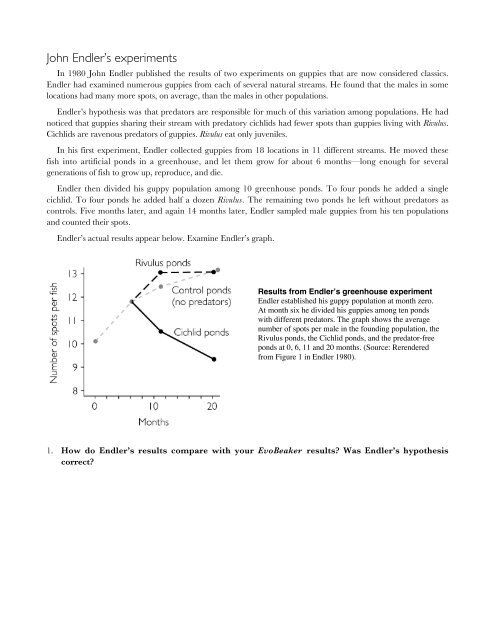John Endler's experiments
John Endler's experiments
John Endler's experiments
Create successful ePaper yourself
Turn your PDF publications into a flip-book with our unique Google optimized e-Paper software.
<strong>John</strong> Endler’s <strong>experiments</strong><br />
In 1980 <strong>John</strong> Endler published the results of two <strong>experiments</strong> on guppies that are now considered classics.<br />
Endler had examined numerous guppies from each of several natural streams. He found that the males in some<br />
locations had many more spots, on average, than the males in other populations.<br />
Endler’s hypothesis was that predators are responsible for much of this variation among populations. He had<br />
noticed that guppies sharing their stream with predatory cichlids had fewer spots than guppies living with Rivulus.<br />
Cichlids are ravenous predators of guppies. Rivulus eat only juveniles.<br />
In his first experiment, Endler collected guppies from 18 locations in 11 different streams. He moved these<br />
fish into artificial ponds in a greenhouse, and let them grow for about 6 months—long enough for several<br />
generations of fish to grow up, reproduce, and die.<br />
Endler then divided his guppy population among 10 greenhouse ponds. To four ponds he added a single<br />
cichlid. To four ponds he added half a dozen Rivulus. The remaining two ponds he left without predators as<br />
controls. Five months later, and again 14 months later, Endler sampled male guppies from his ten populations<br />
and counted their spots.<br />
Endler’s actual results appear below. Examine Endler’s graph.<br />
Results from Endler’s greenhouse experiment<br />
Endler established his guppy population at month zero.<br />
At month six he divided his guppies among ten ponds<br />
with different predators. The graph shows the average<br />
number of spots per male in the founding population, the<br />
Rivulus ponds, the Cichlid ponds, and the predator-free<br />
ponds at 0, 6, 11 and 20 months. (Source: Rerendered<br />
from Figure 1 in Endler 1980).<br />
1. How do Endler’s results compare with your EvoBeaker results? Was Endler’s hypothesis<br />
correct?
In his second experiment, Endler sought to replicate his greenhouse results in the wild. Among the tributaries<br />
of the Aripo River in Trinidad, Endler found a guppy population living with cichlids, a guppy population living<br />
with Rivulus, and a stream that contained Rivulus, but no cichlids or guppies. Endler caught about 200 guppies<br />
from the population living with cichlids and moved them to the stream with Rivulus, but no guppies. He returned<br />
two years later to sample males from all three locations.<br />
Endler’s actual results appear below.<br />
Results of Endler’s field experiment The<br />
green bars show the average number of spots per<br />
fish at the end of the greenhouse experiment. The<br />
blue and orange bars show the results from the<br />
transplantation expeirment. (Source: Rerendered<br />
from Figures 2 and 4 in Endler 1980.)<br />
2. How do Endler’s results compare with your EvoBeaker results? Are the results from his field<br />
experiment consistent with the results from his greenhouse experiment? [If you have time and<br />
your results were different than Endler’s, go back and repeat Endler’s <strong>experiments</strong> in EvoBeaker. You can<br />
move guppies from either lower stream to Meir Creek, which you will already have discovered has Rivulus,<br />
but no guppies.]
Literature Cited<br />
Endler, <strong>John</strong> A. 1980. Natural selection on color patterns in Poecilia reticulata. Evolution 34: 76-91.




